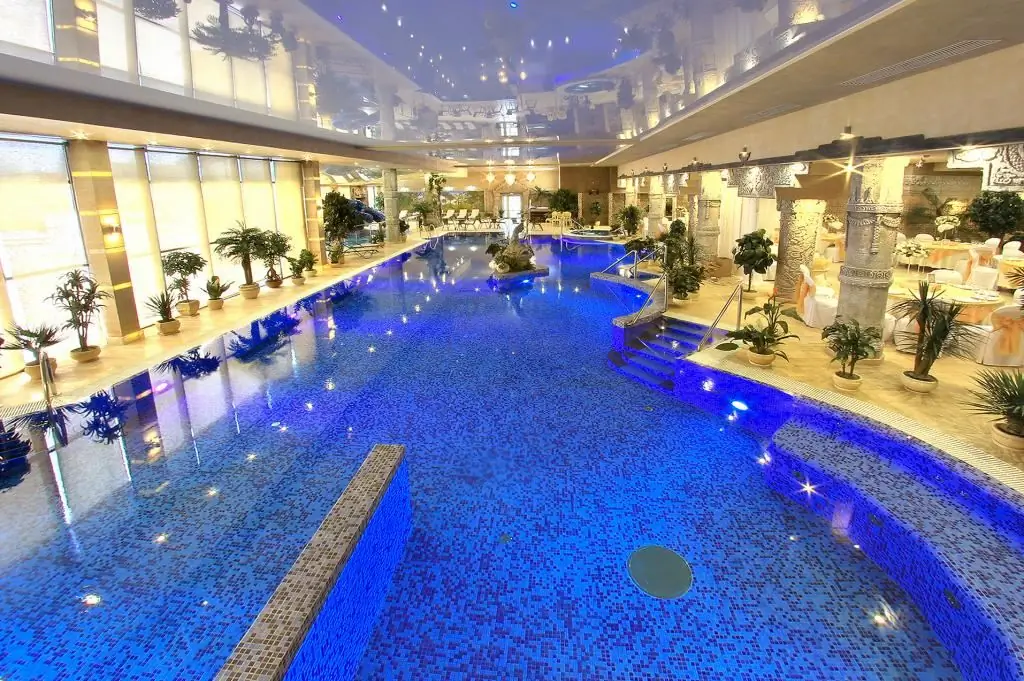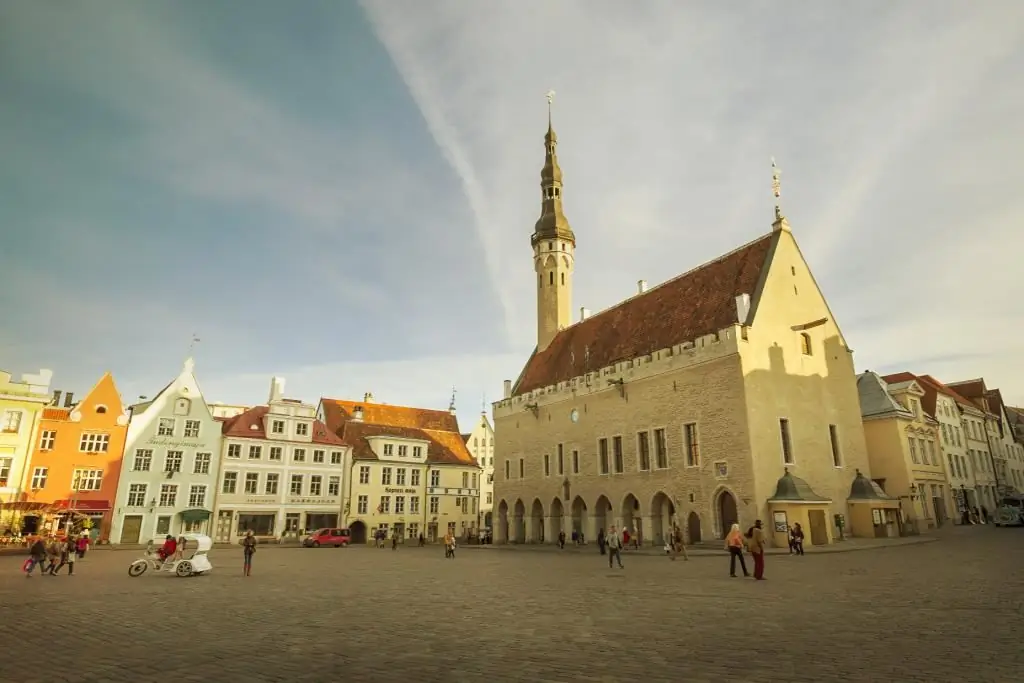- Author Harold Hamphrey [email protected].
- Public 2023-12-17 10:06.
- Last modified 2025-01-24 11:10.
The Spaso-Prilutsky Monastery is one of the largest places of worship in the Russian North. It was named in honor of the Church of the Savior of the monastery and the river bend (hay bow), where it is located. Today it is a complex of architectural monuments of the 16th-18th centuries of republican significance.
A bit of history
The Spaso-Prilutsky Monastery (Vologda region) appeared on this land in 1371, north of Vologda, on the road leading to Beloozero, near the village of Vypryagovo. The famous Russian saint, patron of Vologda Dimitry Prilutsky is considered to be its founder. He erected a wooden church in the monastery, and next to it wooden cells were built for the monks.
The peasants who previously owned these lands, Ilya and Isidor Vypryag, as history shows, were happy to give these territories to a good cause. According to contemporaries, the Spaso-Prilutsky Monastery (Vologda) has always enjoyed the favor and great respect of the Grand Dukes John III, John IV, Vasily III.

When John III wentto Kazan (1503), he took from the monastery the icon of Demetrius of Prilutsky, painted by Dionysius. Returning with victory, he decorated the icon with silver and gold. Spaso-Prilutsky Monastery was visited by Vasily III with his wife Elena Glinskaya (1528) during a pilgrimage to Russian monasteries.
An altar wooden cross - 140 cm high, decorated with numerous carvings made on white bone and covered with gilded basma - was taken from the monastery by John IV during his campaign against Kazan (1552). Historians associate this Cilician cross from the monastery with ancient Cilicia, located in Asia Minor. Now it is stored in the Vologda Museum. According to the historian S. M. Solovyov, Dimitry Prilutsky created a monastery on the paths that led from Vologda to the very Northern Ocean. Spaso-Prilutsky Dimitriev Monastery in the 16th century turned into one of the most famous and richest monasteries in the north of the country.
Architecture
In the center of the monastery is the bell tower and the Cathedral of the Savior. It was the first temple built of stone in the city. In order for its construction to progress faster, Ivan the Terrible, by his Decree, ordered the monastery to be freed from duties. Construction work was completed in 1542. In the same year, the Spaso-Prilutsky Dimitriev Monastery, as well as the built cathedral, was visited by John IV.

The Cathedral is very reminiscent of Moscow places of worship. This is a temple of a cubic shape, two-story, three-apse, four-pillared. It is crowned with five helmet-shaped domes, which are located on the drums.round shape. At the base of the drums there is a cornice, which is decorated with an ornamental cut. The first floor is vaulted, its cross-shaped vaults support four pilasters, their cornices hold three semicircular zakomaras.
According to researchers, the western porch appeared here before the 17th century. The southern and northern ones were built later, in 1672. The porch of the western porch is made up of two pitcher-shaped stone pillars and two half-pillars. They support two arches, which are located on each side. On the western side of the porch, a gable can be seen. A fresco is painted on its smooth surface.
The cathedral noticeably dominates the surrounding buildings and stands out with a majestic view. The cubic monumental volume, set on a high basement, looks very impressive. On three sides the cathedral is surrounded by galleries, and on the east there are three apses.
The walls of the temple are divided by flat and wide shoulder blades into three strands. Above them rise two tiers of semicircular large zakomaras, having a small keel in the middle. Unlike the capital's temples, it was made with the underlined modesty inherent in northern architecture. You should pay attention to the very concise decorative solution of the facades.

The decoration of the drums is somewhat more varied, which consists of runner belts, arches, niches and a curb. In September 1811, a fire broke out from a candle forgotten in the church. All interior decoration burned down. Some chapters were also burned.
When the French invaded the capital (1812d.) in a burnt building, the treasures of the vestry of the patriarchs of Novospassky, Chudov, Ugreshsky, Znamensky, Novodevichy, Pokrovsky, Ascension monasteries, the Trinity-Sergius Lavra and some cathedrals of Moscow were stored. The valuables were in the cathedral until the liberation of the capital.
Restoration of the Cathedral
From 1813 to 1817, restoration work was carried out in the temple. Correcting the damaged domes, it was decided to give them a pitcher-like shape. The burnt walls were completely restored.
Ivan Baranov - Yaroslavl master - with eight assistants inside plastered the walls of the cathedral. A peasant from Vologda M. Gorin in 1841 made a new head of the cathedral and a spire for the bell tower. In the lower floor of the cathedral were the tombs of the Uglich princes John and Demetrius, who were exiled by John III to prison in this northern city, and Demetrius of Prilutsky. In the monastery, John took the tonsure and received the name Ignatius. The tombs of St. Ignatius and Demetrius of Prilutsky have been completely restored today - they are the shrines of the monastery, which are reverently revered by the brethren and pilgrims.

Gate Church
The central gates of the monastery, the gate church located above them, as well as part of the wall were erected after the construction of the Cathedral of the All-Merciful Savior. They decorate the entrance to the Spaso-Prilutsky Monastery from the side of the road leading to Kirillov, Belozersk and Arkhangelsk.
The gate church was consecrated in the name of Theodore Stratilates in 1590, but later renamed it in the nameAscension of the Lord (1841). According to the 17th-century inventories kept by the Spaso-Prilutsky Monastery (Vologda Region), it appears that a stone chapel with four openings, in which bells were installed, was attached to the gate church. The chapel had a chiming wheel clock.
In 1730 the chapel was converted into a small bell tower. To this day, a quadrangle has survived, having four windows, on which an octagon of ringing was built on. In 1914, the only signal bell hung here, weighing 52 pounds. It was cast from old bell copper by master Chartyshnikov (1876). The building is decorated with belts, niches, arches, a runner and a curb on the drum and walls. Such decor, in which one can notice the influence of Novgorod and Moscow, is quite typical for northern stone temples of the 15th-16th centuries. The walls are divided by one spatula into two strands.

Assumption Church
Today the Spaso-Prilutsky Monastery (Vologda) has on its territory a unique wooden Assumption Church, which appeared here in the first half of the 16th century. She was transported from the Alexander-Kusht monastery, which was located near the village of Ustya, on the Kushta River.

This is the oldest monument of wooden architecture in the Russian North. Its architectural form emphasizes the dynamic aspiration to the sky. Above the cruciform volume in the center rises a large octagon, expanding from above. It is called the fall. The octagon is crowned by a slender and high tent and a small cupola. Side pieces (overlowered) end with gracefully curved roofs. The silvery color of individual wooden planks (melech) that cover the roof and the tent is perfectly combined with the velvety brown tint of the logs. All forms of construction are inextricably linked. They form an integral and harmonious volume.
Church of All Saints
The Spaso-Prilutsky Dmitriev Monastery has another interesting church. At first, she was on sick leave, because she was adjacent to the hospital building. One-domed, one-story double-height. It was built in 1721 and consecrated in the name of the Three Hierarchs. Much later (in 1781) it was renamed in the name of All Saints.
Belfry
The pilgrims and brethren of the monastery are especially proud of the bell tower, which has the Spaso-Prilutsky monastery (Vologda region). The first such structure was built along with the cathedral. It adjoined the northwest wing. But it was soon dismantled. The new one, which still exists today, was built in 1654.
In 1736 it had eighteen bells. The most important of them weighed more than 357 pounds. In addition, there was also a signal bell. His weight exceeded 55 pounds. On it was the image of Princes John and Dimitri of Uglich. The bells were cast in 1738 by townsman John Korkutsky. In the upper octagon, a chiming wheel clock was installed. The premises of the lower powerful quarter were adapted for the church and cells.
Vvedenskaya Church
Covered walkways connect the Cathedral of the Savior with the complex of buildings. One of them is the Vvedenskaya Church. This is a one-domed two-story building with an adjoininghim a meal. The time of its construction, unfortunately, is not known for certain. In the monastery inventory of 1623, it is already described as stone.
The lower floor still occupies the temple. In 1876, a chapel was built into this church, consecrated in the name of the Great Martyr Barbara. It should be noted that with its decor, which is made in the form of kokoshniks, it perfectly combines with the Cathedral of the Savior and the gate of the Ascension Church. Decorative belts of balusters, curbs and niches give the temple a very elegant look.
Catherine Church
To the east of the Vvedenskaya Church (ten meters away) there is a small stone church in the name of the Great Martyr Catherine and St. Prince Vladimir. It was built in 1830 at the expense of the landowner from Vologda V. Volotsky. It was built over the graves of his relatives, who were buried here.
Walls and towers
The Vologda Spaso-Prilutsky Monastery in the 17th century was surrounded on three sides by a fence made of wooden beams. At that time, only the central gate and a small section of the wall that adjoined them were made of stone. This was one of the reasons for the destruction of the monastery in 1612-1619. The Spaso-Prilutsky Monastery, the photo of which you can see in our article, was completely enclosed with stone walls with towers in 1656. They were built according to all the rules of building science of the 17th century.
The monastery walls have a quadrilateral (irregular) configuration in plan. At its corners, sixteen-sided towers were built, which are interconnected by high fortress walls. From the north, the main stone gates were builtand Gate Church. On the western side is a rectangular Water Tower with separate gates leading to the river. In the southern wall there is a small (third) gate, which today is bricked up.

The corner towers are significantly extended from the plane of the walls. They were intended for all-round defense. Mounted loopholes (mashikuli) are arranged in tiers in the outer wall of the towers. Corner towers inside, in the center have stone pillars. These are the supports of the rafters of the tent, and inter-tier connections and the base for observation towers.
The walls are equipped with devices for conducting upper and lower battles. On the inner side along the stone arches there is a platform for the upper fight. She is a move around all the walls. The total length of the walls is 830 meters with a height of seven and a half meters.
Today, not only pilgrims, but also ordinary travelers visit the Spaso-Prilutsky Monastery (Vologda). Its opening hours are convenient for visitors. We will talk more about this later.
Outbuildings
The Spaso-Prilutsky Monastery was ruined several times in the 17th century. Thus, in December 1618, detachments of Hetman Shelkovodsky and Cossack ataman Balovny burned 59 monks alive in the refectory, in total, more than two hundred people died during this attack.
Lithuanians and Poles hosted the monastery for three days. They plundered and destroyed the property, partially burned the archive of the monastery. And the next year the monastery was destroyed. This time it was made by the Siberian prince Aleevich, who arrived for the "guard"monastery with Cossacks and Tatars. Another "guard" - Muraz with the Tatars hosted in the holy monastery for nine days.

In 1618, the Lithuanians burned the refectory and services, as well as most of the monastery premises. They stole cattle, once again plundered property, burned villages, and killed the peasants who lived in the vicinity of the monastery. In 1645, instead of the lost wooden cells and a refectory, a stone one-story building with monastic cells with a common refectory was built in the monastery. For their construction, master masons from the Spaso-Yaroslavl Monastery were invited.
The two-storey stone building is the ancient abbot's cells. On the second floor there were rector's living quarters, on the first - cellars. Residential cells of the abbots are connected to the Vvedenskaya Church by a covered passage.
To the west of the Gate Church in 1718, another stone building was built dryer, which was later rebuilt into a two-story structure for winter rectory quarters, and later a hotel for visitors was placed here.
To the east of Nadvratnaya in 1720 a stone two-storey Kelar building was built. Later, the storerooms of the monastery were arranged in it. The residential fraternal building stretches along the northern wall, which ends on the eastern side with the Church of All Saints. It was built for quite a long time (XVII-XVIII centuries), the facade was designed in 1790. Today it houses the cells of the brethren.
Closing the monastery
In Soviet times, the Spaso-Prilutsky Monastery did not escape the sad fate of religious buildings in Russia. In 1918year in the monastery were searched and an inventory of all property. Some of the buildings were placed by the Red Army. During the Civil War, the towers of the monastery played the role of warehouses for explosives. Once, only timely measures taken made it possible to extinguish the fire that had begun in time and save this priceless historical and architectural monument. Until 1923, church valuables were confiscated from the monastery, which, among other things, went to help the starving people of the Volga region.
The county executive committee decided to evict Archimandrite Nifont (Kursin), novices and monks were removed from the monastery, and parishioners who expressed dissatisfaction were repressed. Residents of Pryluky and surrounding villages asked the authorities for permission to dismantle the monastery walls into bricks, but their request was rejected.

In the summer of 1924, the contract with the community was terminated, and the monastery itself was finally closed. All works of art were handed over to the city museum, the rest of the property was transferred to state institutions. In the 1930s, the Svyato-Prilutsky Monastery was turned into a transit prison for the dispossessed, who were then taken to the northern Gulag camps.
From the beginning of the 50s to the end of the 70s, military warehouses were located within the walls of the monastery. At various times, the monastery housed a cinema, a home for the disabled. In the mid-fifties, the crumbling and deserted buildings of the monastery began to be gradually restored. Experts say that the work was carried out very high quality, so many buildings were returned to their original appearance.
Since 1979, it became part of the Vologda Museum-Reserve of the Spaso-Prilutsky Monastery. A tour of its territory was included in the program of the museum "Revival of the Monastery". In mid-June 1990, after the closing of the monastery, for the first time a religious procession took place to the Gorbachev cemetery, where the Church of Lazarus is located. In August of the same year, the Gate Ascension Church was transferred to the Russian Orthodox Church. And in 1991 the diocesan monastery was opened again.
On the day of memory of Dmitry Prilutsky (February 24, 1992), the monastery was returned to the Russian Orthodox Church in full. Gradually, life began to revive in the monastery, monastic buildings were repaired, bells and iconostases were restored. Divine services are performed daily. There is a courtyard on the territory, there is a Sunday school.
In the monastery there is a branch of the Orthodox Theological School of Vologda. It trains clergy for the Veliky Ustyug and Vologda dioceses. Every year Dimitriev's Readings are held here, bringing together educators and clergy.
Since 2014, the rector of the Spaso-Prilutsky Monastery is Metropolitan Ignatius of Kirillov and Vologda. The brethren of the monastery - about 20 people, workers and several civilian workers live here.
Tours
We inform everyone who wants to visit the Spaso-Prilutsky Monastery (Vologda) opening hours.
- Weekdays (Monday to Saturday) - from 10.00 to 17.00.
- Sunday - from 12.30 to 17.00. On the days of patronal holidays, excursions run from 14.00.
Spaso-Prilutsky Monastery: opening hours (services)
Weekdays:
- Matins - 5.00.
- Liturgy - 7.00-7.30
- Confession is held in the left half of the temple.
- Vespers - 17.00.






